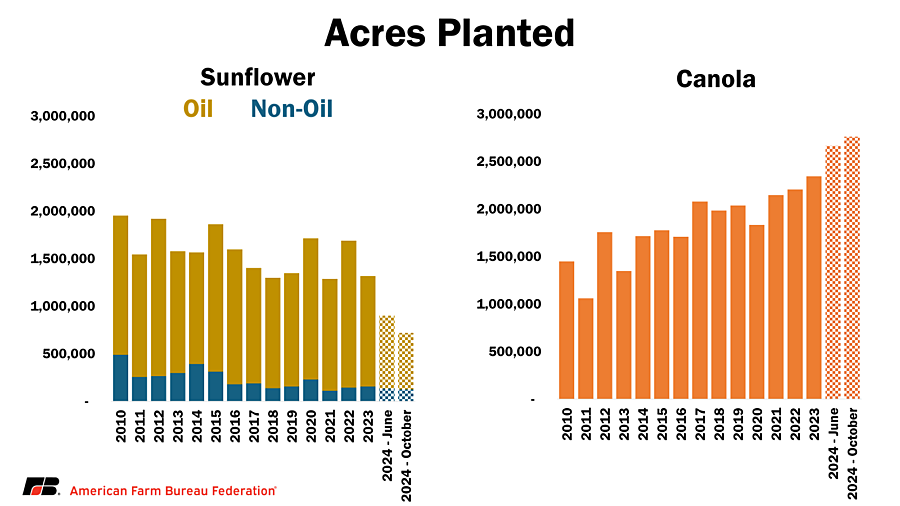By Betty Resnick
The October World Agricultural Supply and Demand Estimates (WASDE) report shed light on wider production swings in a few smaller crops, including canola and sunflowers, and provided new insight into crop losses from Hurricane Helene in cotton, peanuts and pecans.
(The WASDE report fell well within expectations for the four main row crops highlighted in the report: corn, soybeans, wheat and cotton.)
The latest WASDE report incorporated data from the Sept. 30 Quarterly Grain Stocks report, explored in a previous American Farm Bureau Federation Market Intel, and a new Crop Production report.
WASDE Confirms Hurricane Helene Hit Georgia Cotton Hard, But How Hard?
Of the four main crops, cotton expectations changed the most, with a decline in production of 310,000 bales (-2.1%) largely due to a decline of 400,000 bales in Georgia (-19.5%) caused by hurricane damage. Farmers were just beginning to harvest cotton in Georgia when Hurricane Helene struck on Sept. 27. Data collection on crop production for field crops and pecans took place mostly in the immediate aftermath of the hurricane, between September 28 and October 7, so it may not reveal the full impact of the storm’s destruction, so we are more uncertain about the final harvest than we usually are at this time of year.
Crop Production Report Shows Canola and Sunflower Production Heading in Opposite Directions
Canola production is estimated to expand to a record 4.93 billion pounds, up 18.5% from 2023 due largely to an increase in acreage. Planted acreage was revised up an additional 3.6% from previous reports, and 17.7% over 2023, reaching a record 2.76 million acres. North Dakota, which accounts for 77.9% of all canola acres, increased the most with an additional 220,000 acres over 2023. Oklahoma increased the most on a percentage basis, jumping a whopping 600% from only 3,000 acres to 21,000 acres this season.
While canola production has rapidly expanded in part due to rising demand from the biofuel sector, particularly biodiesels, its use in biodiesel is now under threat from the California Air Resource Board’s (CARB) recent proposed plans for a 20% cap on the use of virgin oil from canola, soybeans and sunflowers as a feedstock beginning in 2028. California currently consumes the vast majority of renewable diesel nationwide due to an additional incentive from its Low Carbon Fuel Standard, and 65% of the state’s diesel usage being from renewable diesel in the first quarter of 2024. CARB is set to vote on the proposed cap, among other amendments, on Nov. 8.
There are two main types of sunflowers: confection, which are grown for both human consumption and bird food, and those grown primarily for oil. The largest year-over-year drop in production has occurred in sunflowers grown for oil, which had planted acres fall by 43.6% to 596,500 acres. Comparatively, confection sunflower planted acres (billed as non-oil by USDA) fell by 13.8% to 123,500 acres. The focused drop in sunflowers planted for oil is indicative of a generally weak oilseed market with abundant old-crop oilseed stocks. Due to the significant drop in production, prices for high oleic sunflowers have been inching upward this season, increasing between 6.6% to 9% across three major crush facilities over three months.

Additional Crops Impacted by Hurricane Helene: Peanuts and Pecans
In addition to cotton, large swaths of peanuts and pecans were in the path of Hurricane Helene. Nearly half of the nation’s 1.8 million planted acres of peanuts are in Georgia. Compared to September’s report, production of peanuts is down an estimated 4% (268.4 million pounds) to 6.4 billion pounds but is still up nearly 10% from 2023. Of the month-to-month decline in production projections, Georgia accounts for most of it with a decline of 7.3% (253.5 million pounds) at the state level.
The first estimate of pecan production this year shows an 11.7% year-over-year decrease. The 270.9-million-pound crop would be the smallest since 2021. Georgia, which produces slightly over a third of the country’s pecan crop, is projected to produce 99 million pounds in 2024, a 9-million-pound (-8.3%) decrease since 2023. New Mexico, which also produces roughly a third of the nation’s crop, has seen a steeper decrease – falling 15.3% to 91 million pounds.
Click here to see more...